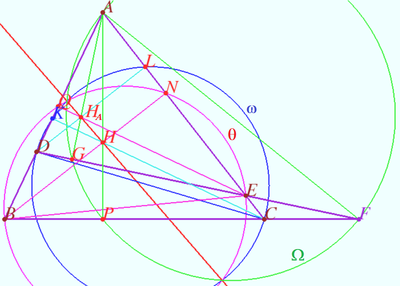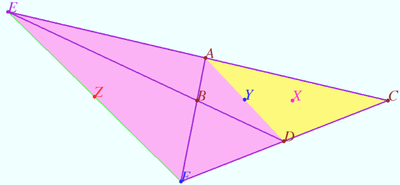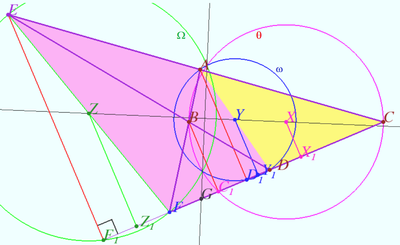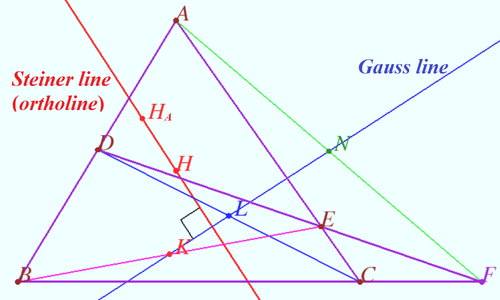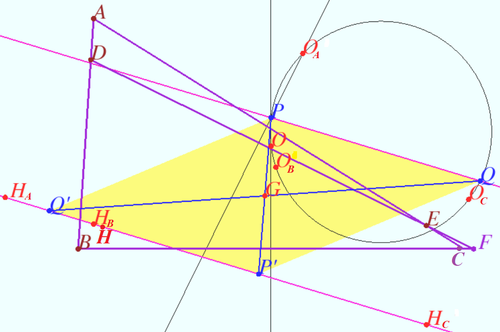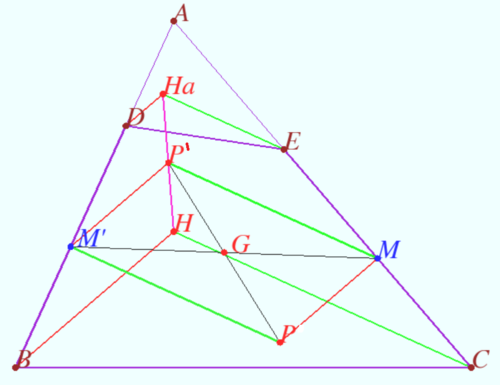Difference between revisions of "Complete Quadrilateral"
(→Areas in complete quadrilateral) |
(→Shatunov-Tokarev line) |
||
| (3 intermediate revisions by the same user not shown) | |||
| Line 40: | Line 40: | ||
<i><b>Proof</b></i> | <i><b>Proof</b></i> | ||
| − | Let <math>X_1, Y_1, D_1, C_1, Z_1,</math> and <math>F_1</math> be the projections of <math>X, Y, A, B, Z,</math> and <math>E,</math> respectively onto <math>CD.</math> | + | [[File:Complete areas 1.png|400px|right]] |
| + | Let <math>X_1, Y_1, D_1, C_1, Z_1,</math> and <math>F_1</math> be the projections of <math>X, Y, A, B, Z,</math> and <math>E,</math> respectively onto <math>CD.</math> | ||
| + | |||
Let <math>\omega, \theta,</math> and <math>\Omega</math> be the circles with diameters <math>AD, BC,</math> and <math>EF,</math> respectively. | Let <math>\omega, \theta,</math> and <math>\Omega</math> be the circles with diameters <math>AD, BC,</math> and <math>EF,</math> respectively. | ||
| − | < | + | <cmath>\angle EF_1F = 90^\circ \implies F_1 \in \Omega.</cmath> |
| + | Similarly <math>D_1 \in \omega, C_1 \in \theta.</math> | ||
| + | |||
Let common radical axes of <math>\omega, \Omega,</math> and <math>\theta</math> cross <math>CD</math> at point <math>G.</math> | Let common radical axes of <math>\omega, \Omega,</math> and <math>\theta</math> cross <math>CD</math> at point <math>G.</math> | ||
| − | < | + | <cmath>EF_1 || AD_1 \implies \frac {EC}{AC} = \frac {F_1C}{D_1C}.</cmath> |
| − | The power of the point <math>G</math> with respect <math>\omega, theta,</math> and <math>\Omega</math> is the same, therefore | + | The power of the point <math>G</math> with respect <math>\omega, \theta,</math> and <math>\Omega</math> is the same, therefore |
| − | < | + | <cmath>GF \cdot GF_1 = GC \cdot GC_1 = GD \cdot GD_1 \implies </cmath> |
| − | < | + | <cmath>(\vec G - \vec F) \cdot (\vec G - \vec F_1) = (\vec G - \vec C) \cdot (\vec G - \vec C_1) = (\vec G - \vec D) \cdot (\vec G – \vec D_1) \implies </cmath> |
| − | <cmath>F \cdot F_1 – G \cdot (F + F_1) = F \cdot F_1 – G \cdot | + | <cmath>\vec F \cdot \vec F_1 – \vec G \cdot (\vec F + \vec F_1) = \vec F \cdot \vec F_1 – \vec G \cdot 2\vec Z_1 = \vec C \cdot \vec C_1 – \vec G \cdot (\vec C + \vec C_1) =</cmath> |
| − | < | + | <cmath>= \vec C \cdot \vec C_1 - \vec G \cdot 2\vec X_1 = \vec D \cdot \vec D_1 – \vec G \cdot (\vec D + \vec D_1) = \vec D \cdot \vec D_1 - \vec G \cdot 2\vec Y_1 \implies</cmath> |
| − | < | + | |
| − | < | + | <cmath>|\vec G| = \frac {\vec F \cdot\vec F_1 - \vec C \cdot \vec C_1}{2|\vec Z_1 - \vec X_1|} = \frac {\vec D \cdot \vec D_1 - \vec C \cdot \vec C_1}{2|\vec Y_1 – \vec X_1|} \implies</cmath> |
| − | < | + | <cmath>\frac {|\vec Z_1 - \vec X_1|}{|\vec Y_1 - \vec X_1|} = \frac {\vec F \cdot \vec F_1 - \vec C \cdot \vec C_1} {\vec D \cdot \vec D_1 - \vec C \cdot\vec C_1} = \frac {Z_1X_1}{Y_1X_1} = \frac {ZX}{YX} .</cmath> |
| − | Therefore <cmath>\frac {[ADEF]}{[ | + | Let <math>\vec C = \vec 0 \implies \vec C \cdot\vec C_1 = 0, \vec F \cdot \vec F_1 = FC \cdot F_1C, \vec D \cdot \vec D_1 = DC \cdot D_1C.</math> |
| + | <cmath>\frac {ZX}{YX} = \frac {FC \cdot F_1C} {DC \cdot D_1C} = \frac {FC \cdot EC} {DC \cdot AC} = \frac {[CEF]}{[CAD]}.</cmath> | ||
| + | |||
| + | Therefore <cmath>\frac {[ADEF]}{[CAD]} = \frac {[CEF]-[CAD]}{[CAD]} =\frac {ZX - YX}{YX} = \frac {ZY}{YX}.</cmath> | ||
'''vladimir.shelomovskii@gmail.com, vvsss''' | '''vladimir.shelomovskii@gmail.com, vvsss''' | ||
| Line 116: | Line 123: | ||
Therefore line <math>P'Q'</math> coincide with Steiner line and line <math>PQ</math> is symmetric to Steiner line with respect <math>G</math> and is parallel to this line. | Therefore line <math>P'Q'</math> coincide with Steiner line and line <math>PQ</math> is symmetric to Steiner line with respect <math>G</math> and is parallel to this line. | ||
| + | |||
| + | '''vladimir.shelomovskii@gmail.com, vvsss''' | ||
| + | ==Complete quadrilateral theorem== | ||
| + | [[File:Complete quadrilateral map.png|350px|right]] | ||
| + | Let points <math>A, B, C, D,</math> no three of which are collinear, be given. | ||
| + | <cmath>P = AD \cap BC, Q = AC \cap BD, E = AB \cap PQ, F = CD \cap PQ.</cmath> | ||
| + | Prove that <math>\frac{QE \cdot PF}{PE \cdot QF} = 1.</math> | ||
| + | |||
| + | <i><b>Proof</b></i> | ||
| + | |||
| + | We make the projective transformation of the vertices of <math>ABCD</math> into vertices of the square. ([[Projective geometry (simplest cases) |Projecting non-convex quadrilateral into rectangle]]) | ||
| + | Then image of the point <math>P</math> is the point at infinity, image of <math>Q</math> is the center of the square, images of <math>AD, PQ,</math> and <math>BC</math> are parallel, so for images <math>QF = QE</math> and <cmath>\frac {PE}{PF} = 1 \implies \frac{QE \cdot PF}{PE \cdot QF} = 1.</cmath> | ||
| + | |||
| + | The double ratio <math>\frac{QE \cdot PF}{PE \cdot QF}</math> is the projective invariant of a quadruple of collinear points <math>(P,Q;E,F)</math> so the equality also holds for the preimages. | ||
'''vladimir.shelomovskii@gmail.com, vvsss''' | '''vladimir.shelomovskii@gmail.com, vvsss''' | ||
Latest revision as of 03:42, 21 November 2024
Contents
Complete quadrilateral
Let four lines made four triangles of a complete quadrilateral. In the diagram these are ![]() One can see some of the properties of this configuration and their proof using the following links.
One can see some of the properties of this configuration and their proof using the following links.
Radical axis
Let four lines made four triangles of a complete quadrilateral. In the diagram these are ![]()
Let points ![]() and
and ![]() be the orthocenters of
be the orthocenters of ![]() and
and ![]() respectively.
respectively.
Let circles ![]() and
and ![]() be the circles with diameters
be the circles with diameters ![]() and
and ![]() respectively.
Prove that Steiner line
respectively.
Prove that Steiner line ![]() is the radical axis of
is the radical axis of ![]() and
and ![]()
Proof
Let points ![]() and
and ![]() be the foots of perpendiculars
be the foots of perpendiculars ![]() and
and ![]() respectively.
respectively.
Denote ![]() power of point
power of point ![]() with respect the circle
with respect the circle ![]()
![]()
![]()
![]()
![]()
![]()
![]() Therefore power of point
Therefore power of point ![]() with respect these three circles is the same. These points lies on the common radical axis of
with respect these three circles is the same. These points lies on the common radical axis of ![]() and
and ![]() Steiner line
Steiner line ![]() is the radical axis as desired.
is the radical axis as desired.
vladimir.shelomovskii@gmail.com, vvsss
Areas in complete quadrilateral
Let complete quadrilateral ![]() be given
be given ![]() . Let
. Let ![]() and
and ![]() be the midpoints of
be the midpoints of ![]() and
and ![]() respectively.
respectively.
Prove that ![]() where
where ![]() is the area of
is the area of ![]()
Proof
Let ![]() and
and ![]() be the projections of
be the projections of ![]() and
and ![]() respectively onto
respectively onto ![]()
Let ![]() and
and ![]() be the circles with diameters
be the circles with diameters ![]() and
and ![]() respectively.
respectively.
![]() Similarly
Similarly ![]()
Let common radical axes of ![]() and
and ![]() cross
cross ![]() at point
at point ![]()
![]() The power of the point
The power of the point ![]() with respect
with respect ![]() and
and ![]() is the same, therefore
is the same, therefore
![]()
![]()
![]()
![]()
![\[|\vec G| = \frac {\vec F \cdot\vec F_1 - \vec C \cdot \vec C_1}{2|\vec Z_1 - \vec X_1|} = \frac {\vec D \cdot \vec D_1 - \vec C \cdot \vec C_1}{2|\vec Y_1 – \vec X_1|} \implies\]](http://latex.artofproblemsolving.com/7/2/6/726080ec6f893b4dc3307cf9c8af2433b310f187.png)
![\[\frac {|\vec Z_1 - \vec X_1|}{|\vec Y_1 - \vec X_1|} = \frac {\vec F \cdot \vec F_1 - \vec C \cdot \vec C_1} {\vec D \cdot \vec D_1 - \vec C \cdot\vec C_1} = \frac {Z_1X_1}{Y_1X_1} = \frac {ZX}{YX} .\]](http://latex.artofproblemsolving.com/7/6/d/76dec48af04d87fd1e562c6ca64ca179f3b24320.png) Let
Let ![]()
![]()
Therefore ![]()
vladimir.shelomovskii@gmail.com, vvsss
Newton–Gauss line
Let four lines made four triangles of a complete quadrilateral.
In the diagram these are ![]()
Let points ![]() and
and ![]() be the midpoints of
be the midpoints of ![]() and
and ![]() respectively.
respectively.
Let points ![]() and
and ![]() be the orthocenters of
be the orthocenters of ![]() and
and ![]() respectively.
respectively.
Prove that Steiner line ![]() is perpendicular to Gauss line
is perpendicular to Gauss line ![]()
Proof
Points ![]() and
and ![]() are the centers of circles with diameters
are the centers of circles with diameters ![]() and
and ![]() respectively.
respectively.
Steiner line ![]() is the radical axis of these circles.
is the radical axis of these circles.
Therefore ![]() as desired.
as desired.
vladimir.shelomovskii@gmail.com, vvsss
Shatunov-Tokarev line
Let the complete quadrilateral ABCDEF be labeled as in the diagram. Quadrilateral ![]() is not cyclic.
is not cyclic.
Let points ![]() be the orthocenters and points
be the orthocenters and points ![]() be the circumcenters of
be the circumcenters of ![]() and
and ![]() respectively.
respectively.
Let bisector ![]() cross bisector
cross bisector ![]() at point
at point ![]() Let bisector
Let bisector ![]() cross bisector
cross bisector ![]() at point
at point ![]()
Prove that
a) points ![]() and
and ![]() lie on circumcircle of
lie on circumcircle of ![]()
b) line ![]() is symmetric to Steiner line with respect centroid of
is symmetric to Steiner line with respect centroid of ![]()
I suppose that this line was found independently by two young mathematicians Leonid Shatunov and Alexander Tokarev in 2022. I would be grateful for information on whether this line was previously known.
Proof
a) Points ![]() and
and ![]() lies on bisector of
lies on bisector of ![]() points
points ![]() and
and ![]() lies on bisector of
lies on bisector of ![]()
![]() circle
circle ![]()
Similarly ![]() circle
circle ![]() as desired.
as desired.
b) Let ![]() and
and ![]() be midpoints of
be midpoints of ![]() and
and ![]() respectively.
respectively.
It is clear that ![]() is centroid of
is centroid of ![]()
![]() (midline of trapezium
(midline of trapezium ![]()
![]()
![]() (midline of trapezium
(midline of trapezium ![]()
![]() is parallelogram.
is parallelogram.
Similarly one can prove that point ![]() the midpoint of
the midpoint of ![]() is symmetric to
is symmetric to ![]() with respect
with respect ![]()
Therefore line ![]() coincide with Steiner line and line
coincide with Steiner line and line ![]() is symmetric to Steiner line with respect
is symmetric to Steiner line with respect ![]() and is parallel to this line.
and is parallel to this line.
vladimir.shelomovskii@gmail.com, vvsss
Complete quadrilateral theorem
Let points ![]() no three of which are collinear, be given.
no three of which are collinear, be given.
![]() Prove that
Prove that ![]()
Proof
We make the projective transformation of the vertices of ![]() into vertices of the square. (Projecting non-convex quadrilateral into rectangle)
Then image of the point
into vertices of the square. (Projecting non-convex quadrilateral into rectangle)
Then image of the point ![]() is the point at infinity, image of
is the point at infinity, image of ![]() is the center of the square, images of
is the center of the square, images of ![]() and
and ![]() are parallel, so for images
are parallel, so for images ![]() and
and ![]()
The double ratio ![]() is the projective invariant of a quadruple of collinear points
is the projective invariant of a quadruple of collinear points ![]() so the equality also holds for the preimages.
so the equality also holds for the preimages.
vladimir.shelomovskii@gmail.com, vvsss





